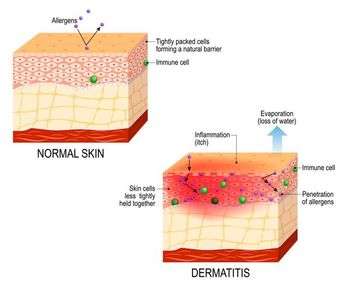
Pruritic Urticarial Papules and Plaques of Pregnancy
This tongue-twister of a dermatosis is the most common type seen during pregnancy and primarily occurs in women carrying twins or triplets.
[[{"type":"media","view_mode":"media_crop","fid":"32391","attributes":{"alt":"Pruritic urticarial papules and plaques of pregnancy PUPPP","class":"media-image","id":"media_crop_1014044642841","media_crop_h":"0","media_crop_image_style":"-1","media_crop_instance":"3427","media_crop_rotate":"0","media_crop_scale_h":"0","media_crop_scale_w":"0","media_crop_w":"0","media_crop_x":"0","media_crop_y":"0","title":" ","typeof":"foaf:Image"}}]]
A 32-year-old woman who is 35 weeks pregnant (primigravida) with twins, presents with erythematous coalescing papules within the striae of her abdomen surrounding the umbilicus. The patient states that the lesions are extremely pruritic and that they began as small pink papules which spread and now have begun to involve her thighs.
Key Point: This pregnant patient presented with an intensely pruritic rash involving the abdominal straie and sparing the periumbilical area. Patient history, morphology, and location favor a diagnosis of pruritic urticarial papules and plaques of pregnancy (PUPPP) or “polymorphous eruption of pregnancy.” This is the most common pregnancy-related dermatosis and is seen in the third trimester, primarily in patients carrying twins or triplets and associated with maternal obesity. Patients present with erythematous papules but may have vesicles or targetoid or annular lesions as well. Histology is nonspecific and includes epidermal spongiosis and parakaratosis and a perviascular lymphocytic infiltrate with dermal edema.
Treatment: Treatment is anecdotal and includes emollients, potent topical corticosteroids, and oral antihistamines for pruritus. Lesions resolve within 1 to 2 weeks following delivery.
Note: There is no fetal or neonatal risk associated with PUPPP and mothers are unlikely to present with these sympoms in future pregnancies.
Newsletter
Enhance your clinical practice with the Patient Care newsletter, offering the latest evidence-based guidelines, diagnostic insights, and treatment strategies for primary care physicians.





























































































































































































































































































